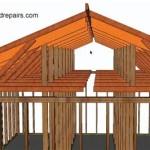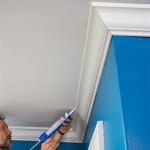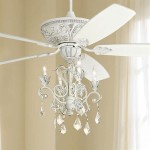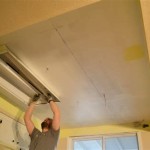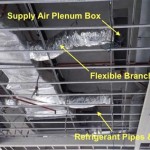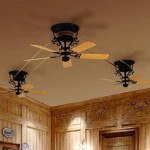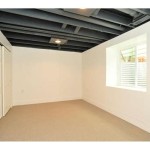Can You Put a Flush Mount Ceiling Fan On a Slanted Ceiling?
Ceiling fans are a popular choice for homeowners seeking to improve air circulation and regulate room temperature. While standard ceiling fans are designed for flat ceilings, many homes feature sloped or angled ceilings, raising the question of compatibility with flush mount or hugger ceiling fans. This article explores the possibility of installing a flush mount ceiling fan on a slanted ceiling, examining the limitations, necessary adaptations, and alternative solutions to achieve safe and effective installation.
A flush mount ceiling fan, also known as a hugger fan, is designed to be installed close to the ceiling, minimizing the distance between the fan blades and the ceiling surface. This design is particularly beneficial for rooms with low ceilings where a standard downrod-mounted fan might compromise headroom. However, the inherent close proximity of a flush mount fan to the ceiling presents challenges when it comes to installation on a sloped or angled surface.
Understanding the Challenges of Slanted Ceilings
Slanted ceilings present several challenges for ceiling fan installation, regardless of the fan type. The primary issues stem from maintaining proper blade clearance and ensuring the fan's stability and safety. When a ceiling is sloped, a standard ceiling fan, even a flush mount, may not hang vertically, potentially causing the blades to hit the ceiling. This can result in noise, vibration, and damage to both the fan and the ceiling. Furthermore, an improperly installed fan on a sloped ceiling can be unstable, posing a safety risk.
The slope of the ceiling, measured in degrees, is a crucial factor in determining the feasibility of installing a flush mount fan. Steeper slopes present greater challenges. Most flush mount fans are designed for flat ceilings or ceilings with a very slight incline, typically no more than a few degrees. Attempting to install a standard flush mount fan on a ceiling with a significant slope can lead to operational issues and safety hazards.
Another consideration is the junction box. It is critical that the junction box is properly rated to support the weight and motion of a ceiling fan. For slanted ceilings, a specialized junction box designed for such applications is often necessary. These boxes are typically angled or adjustable to ensure the fan hangs correctly and the weight is distributed evenly.
Adapting Flush Mount Fans for Slanted Ceilings: Feasibility and Limitations
While standard flush mount ceiling fans are not inherently designed for slanted ceilings, there are situations where modifications or adaptations can make installation possible. The key lies in accommodating the slope and ensuring the fan hangs vertically, maintaining adequate blade clearance.
In some cases, a specialized adapter or mounting bracket can be used to compensate for the slope. These adapters are designed to create a level mounting surface for the flush mount fan, allowing it to hang vertically even on a slanted ceiling. The adapter essentially acts as an interface between the sloped ceiling and the flat mounting surface of the fan.
However, the use of adapters is typically limited to ceilings with a moderate slope. Steeper slopes may require more extensive modifications or alternative solutions. It is important to consult the fan manufacturer's instructions and recommendations to determine the maximum allowable slope for using an adapter. Exceeding these limitations can compromise the safety and performance of the fan.
Another important factor is the availability of space. Even with an adapter, the flush mount fan will still take up vertical space. In rooms with already low ceilings, adding an adapter may further reduce headroom, potentially making the fan impractical. It is essential to carefully measure the ceiling height and consider the overall aesthetic impact before proceeding with the installation.
Alternative Solutions: Downrod Fans and Angled Mounts
When installing a standard flush mount ceiling fan on a slanted ceiling is not feasible due to the steepness of the slope or other limitations, alternative solutions are available. These include using a downrod ceiling fan with an angled mount or choosing a ceiling fan specifically designed for sloped ceilings.
Downrod ceiling fans are designed to hang from a downrod, a metal pipe that extends from the fan motor to the mounting bracket. This allows the fan to hang lower from the ceiling, providing more clearance for the blades. When installing a downrod fan on a slanted ceiling, an angled mount, also known as a sloped ceiling adapter, is used. This adapter allows the downrod to hang vertically, even when the mounting surface is sloped. The angle of the adapter is chosen to match the slope of the ceiling, ensuring that the fan hangs plumb.
Some ceiling fan manufacturers offer models specifically designed for sloped ceilings. These fans typically feature a ball-and-socket mounting system that allows the fan to adjust to the angle of the ceiling. This type of mounting system provides greater flexibility and can accommodate steeper slopes than traditional flush mount fans or downrod fans with angled mounts. These specialized ceiling fans often include longer downrods to increase blade clearance and improve airflow in rooms with high ceilings.
Regardless of the chosen solution, proper installation is crucial for ensuring the safety and performance of the ceiling fan. It is highly recommended to consult a qualified electrician or experienced handyman for assistance, particularly when dealing with electrical wiring and structural modifications. A professional can assess the ceiling slope, determine the appropriate mounting solution, and ensure that the fan is installed correctly and safely.
In summary, while it is possible to adapt a flush mount ceiling fan for use on a slightly slanted ceiling with the appropriate adapter, more significant slopes require alternative solutions such as downrod fans with angled mounts or ceiling fans designed specifically for sloped ceilings. Consulting manufacturer specifications and seeking professional assistance are vital steps in ensuring a safe and effective installation.

How To Install A Ceiling Fan On Sloped Lemon Thistle

How To Install A Ceiling Fan On Sloped Lemon Thistle

Fans On An Angle Installing Ceiling Angled Or Raked

How To Choose A Ceiling Fan For Vaulted Ceilings Lightology

Vaulted Sloped Ceiling Adapter For Modern Fan Company Fans Stardust

How To Choose A Ceiling Fan For Vaulted Ceilings Lightology

Ceiling Fans For Angled Ceilings

How To Install A Ceiling Fan On Sloped Lemon Thistle

Vaulted Sloped Ceiling Adapter For Modern Fan Company Fans Stardust

How To Choose A Ceiling Fan For Vaulted Ceilings Lightology
Related Posts

